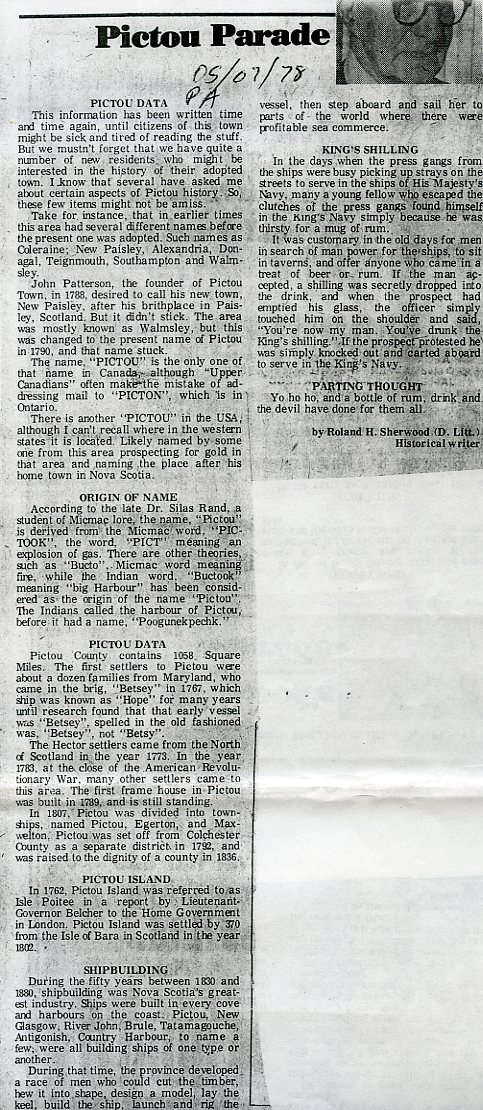
Pictou Parade
05/07/78
PICTOU DATA
This information has been written time and time again, until of this town might be sick and tired of reading the stuff. But we mustn’t forget that we have quite a number of new residents who might be interested in the history of their adopted town. I know that several have asked me about certain aspects of Pictou history. So these few items might not be amiss.
Take for instance, that in earlier times this area had several different names before the present one was adopted. Such names as Colerain, New Paisley, Alexandria, Donegal, Teignmouth, Southampton and Walmsley.
John Patterson, the founder of Pictou Town, in 1788, desired to call his new town New Paisley, after his birthplace in Paisley, Scotland. But it didn’t stick. The area was mostly known as Walmsley7, but this was changed to the present name of Pictou in 1790, and that name suck.
The name “PICTOU” is the only one of that name in Canada, although “Upper Canadians” often make the mistake of addressing mail to “PICTON”, which is in Ontario.
There is another “PICTOU” in the USA, although I can’t recall where in the western states it is located. Likely named by someone from this are prospecting for gold in that area prospecting for gold in that area and naming the place after his home town in Nova Scotia.
ORGIN OF NAME
According to the late Dr. Silas Rand, a student of Micmac lore, the name, “Pictou” is derived from the Micmac word, “PICTOOK,” the word, “PICT” meaning an explosion of gas. There are other theories, such as “Bucto” Micmac word meaning fire, while the Indian word, “Buctook” meaning “big harbor” has been considered as the origin of the name “Pictou.” The Indians called the harbor of Pictou, before it had a name, “Poogunepechk.”
PICTOU DATA
Pictou County contains 1058 Square Miles. The first settlers to Pictou were about a dozen families from Maryland, who came in the brig, “Betsey” in 1767, which ship was known as “Hope “for many years until research found that that early vessel was “Betsey” spelled in the old fashioned was, “Betsey not “Betsy.”
The Hector settlers come from the North of Scotland in the year 1773. In the year 1783, at the close of the American Revolutionary War, many other settlers came to this area. The first frame house in Pictou was built in 1789, and is still standing.
In 1807, Pictou was divided into townships, named Pictou, Egerton, and Maxwelton, Pictou was set off from Colchester County as a separate district in 1792, and was raised to the dignity of a county in 1836.
PICTOU ISLAND
In 1762, Pictou Island was referred to as Isle Poitee in a report by the Lieutenant-Governor Belcher to the Home Government in London; Pictou Island was settled by 370 from the Isle of Bara in Scotland in the year 1802.
SHIP BUILDING
During the fifty years between 1830 and 1880, ship building was Nova Scotia’s greatest industry. Ships were built in every cove and harbors on the coast. Pictou, New Glasgow, River John, Brule, Tatamogouche, Antigonish, County Harbour, to name a few, were all building ships of one type of another.
During that time, the province developed a race of men who could cut the timber, hew it into shape, design a model, lay the keel, build the ship, launch and rig the vessel, then step aboard and sail her to parts of the world where there were profitable sea commerce.
KINGS SHILLING
In the days when the press gangs from the ships were busy picking up strays on the streets to serve I the ships of His Majesty’s Navy, many a young fellow who escaped the clutches of the press gangs found himself in the King’s Navy simply because he was thirsty for a mug of rum.
It was customary in the old days for men in search of man power for the ships, to sit in taverns, and offer anyone who came in a treat of beer or rum. If the man accepted, a shilling was secretly dropped into the drink, and when the prospect has emptied his glass, the officer simply touched him on the shoulder and said, “You’re now a man. You’ve drunk the King’s shilling.” If the prospect protested his was simply knocked out and carted aboard to serve in the King’s Navy.
PARTING THOUGHT
Yo ho ho, and a bottle of rum, drink and the devil have done for them all.
By Roland H. Sherwood (D. Litt.)
Historical Writer
Vault Roland Sherwood File
| File number: | 01-597.15B |
| Contributor: |
|
| Tags: | John Patterson, Dr Silas Rand, Betsey, Belcher, Roland Sherwood, Pictou, Micmac |
| Views: | 1634 |
| Uploaded on: | September 21, 2016 |